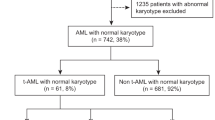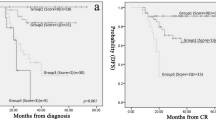Abstract
Patients with acute myeloid leukemia (AML) with the t(8;21) karyotype generally have a favorable clinical course, but key prognostic factors remain poorly defined. This study was conducted to determine the prognoses and treatment outcomes of patients with AML with this unique cytogenetic change. A total of 22 patients with AML with t(8;21)(q22;q22) were studied. Various parameters were tested for their impact on disease-free survival (DFS) and overall survival (OS). Another 55 patients with AML with a normal karyotype were included for comparison of clinical outcomes. Between patients with t(8;21) and those with a normal karyotype, no significant differences were noted in DFS (median survival, 15.23 vs 12.03 mo;P=.7626) and OS (median survival, 19.17 vs 18.93 mo;P=.7543). Among t(8;21)(q22;q22) patients, no clinical parameters showed a significant impact on DFS. Univariate analysis revealed that a higher platelet count (> 15·109/L) at diagnosis, a low white blood cell count (index ≤20), and hematopoietic stem cell transplantation (HSCT) as postremission therapy were associated with improved OS. On multivariate analysis, HSCT as postremission therapy and white blood cell count index < 20 remained good independent prognostic factors for OS. The data presented here suggest that t(8;21)(q22;q22) cytogenetic changes in patients with AML had prognostic significance similar to that in patients with a normal karyotype; patients who harbored either karyotype had parallel clinical outcomes. It is concluded that patients with AML with t(8;21)(q22;q22) would be compromised by treatment approaches that do not include HSCT as postremission therapy.
Similar content being viewed by others
References
Berger R, Bernheim A, Ochoa-Noguera ME, et al. Prognostic significance of chromosomal abnormalities in acute nonlymphocytic leukemia: a study of 343 patients.Cancer Genet Cytogenet. 1987;28:293–299.
Dastugue N, Payen C, Lafage-Pochitaloff M, et al, for the BGMT Group. Prognostic significance of karyotype in de novo adult acute myeloid leukemia.Leukemia. 1995;9:1491–1498.
Keating MJ, Smith TL, Kantarjian H, et al. Cytogenetic pattern in acute myelogenous leukemia: a major reproducible determinant of outcome.Leukemia. 1988;2:403–412.
Mrozek K, Heinonen K, de la Chapelle A, Bloomfield CD. Clinical significance of cytogenetics in acute myeloid leukemia.Semin Oncol. 1997;24:17–31.
Schiffer CA, Lee EJ, Tomiyasu T, Wiernik PH, Testa JR. Prognostic impact of cytogenetic abnormalities in patients with de novo acute nonlymphocytic leukemia.Blood. 1989;73:263–270.
Stasi R, Del Poeta G, Masi M, et al. Incidence of chromosome abnormalities and clinical significance of karyotype in de novo acute myeloid leukemia.Cancer Genet Cytogenet. 1993;67:28–34.
Bloomfield CD, Shuma C, Regal L, et al. Long-term survival of patients with acute myeloid leukemia: a third follow-up of the Fourth International Workshop on Chromosomes in Leukemia.Cancer. 1997;80:2191–2198.
Bloomfield CD, Herzig GP, Peterson BA, Wolff SN. Long-term survival of patients with acute myeloid leukemia: updated results from two trials evaluating postinduction chemotherapy.Cancer. 1997;80:2186–2190.
Burnett AK, Goldstone AH, Stevens RM, et al. Randomised comparison of addition of autologous bone-marrow transplantation to intensive chemotherapy for acute myeloid leukaemia in first remission: results of MRC AML 10 trial. UK Medical Research Council Adult and Children’s Leukaemia Working Parties.Lancet. 1998;351:700–708.
Cassileth PA, Harrington DP, Appelbaum FR, et al. Chemotherapy compared with autologous or allogeneic bone marrow transplantation in the management of acute myeloid leukemia in first remission.N Engl J Med. 1998;339:1649–1656.
Zittoun RA, Mandelli F, Willemze R, et al, for the European Organization for Research and Treatment of Cancer (EORTC) and the Gruppo Italiano Malattie Ematologiche Maligne dell’Adulto (GIMEMA) Leukemia Cooperative Groups. Autologous or allogeneic bone marrow transplantation compared with intensive chemotherapy in acute myelogenous leukemia.N Engl J Med. 1995;332:217–223.
Chalandon Y, Barnett MJ, Horsman DE, et al. Influence of cytogenetic abnormalities on outcome after allogeneic bone marrow transplantation for acute myeloid leukemia in first complete remission.Biol Blood Marrow Transplant. 2002;8:435–443.
Keating S, Suciu S, de Witte T, et al. Prognostic factors of patients with acute myeloid leukemia (AML) allografted in first complete remission: an analysis of the EORTC-GIMEMA AML 8A trial. The European Organization for Research and Treatment of Cancer (EORTC) and the Gruppo Italiano Malattie Ematologiche Maligne dell’ Adulto (GIMEMA) Leukemia Cooperative Groups.Bone Marrow Transplant. 1996;17:993–1001.
Lee KW, Choi IS, Roh EY, et al. Adult patients with t(8;21) acute myeloid leukemia had no superior treatment outcome to those without t(8;21): a single institution’s experience.Ann Hematol. 2004;83:218–224.
Fenaux P, Lai JL, Preudhomme C, Jouet JP, Deminatti M, Bauters F. Is translocation (8;21) a “favorable” cytogenetic rearrangement in acute myeloid leukemia?Nouv Rev Fr Hematol. 1990;32:179–182.
Ma SK, Au WY, Kwong YL, Lam CK, Liang RH, Chan LC. Hematological features and treatment outcome in acute myeloid leukemia with t(8;21).Hematol Oncol. 1997;15:93–103.
International System for Human Cytogenetic Nomenclature (ISCN). Report of the Standing Committee on Human Cytogenetic Nomenclature.Birth Defects Orig Artic Ser. 1985;21:1–117.
Nguyen S, Leblanc T, Fenaux P, et al. A white blood cell index as the main prognostic factor in t(8;21) acute myeloid leukemia (AML): a survey of 161 cases from the French AML Intergroup.Blood. 2002;99:3517–3523.
Cheson BD, Bennett JM, Kopecky KJ, et al. Revised recommendations of the International Working Group for Diagnosis, Standardization of Response Criteria, Treatment Outcomes, and Reporting Standards for Therapeutic Trials in Acute Myeloid Leukemia.J Clin Oncol. 2003;21:4642–4649.
Kaplan E, Meier P. Nonparametric estimation from incomplete observations.J Am Stat Assoc. 1985;53:457–481.
Trujillo JM, Cork A, Ahearn MJ, Youness EL, McCredie KB. Hematologic and cytologic characterization of 8/21 translocation acute granulocytic leukemia.Blood. 1979;53:695–706.
Grimwade D, Walker H, Oliver F, et al. The importance of diagnostic cytogenetics on outcome in AML: analysis of 1,612 patients entered into the MRC AML 10 trial. The Medical Research Council Adult and Children’s Leukaemia Working Parties.Blood 1998;92:2322–2333.
Slovak ML, Kopecky KJ, Cassileth PA, et al. Karyotypic analysis predicts outcome of preremission and postremission therapy in adult acute myeloid leukemia: a Southwest Oncology Group/Eastern Cooperative Oncology Group Study.Blood. 2000;96:4075–4083.
Hann IM, Webb DK, Gibson BE, Harrison CJ. MRC trials in childhood acute myeloid leukaemia.Ann Hematol. 2004;83(suppl 1):S108-S112.
Felice MS, Zubizarreta PA, Alfaro EM, et al. Good outcome of children with acute myeloid leukemia and t(8;21)(q22;q22), even when associated with granulocytic sarcoma: a report from a single institution in Argentina.Cancer. 2000;88:1939–1944.
Chauffaille ML, Yamamoto M, Moncau JE, Braga GW, Souto EX, Kerbauy J. Cytogenetic abnormalities as prognostic factors in acute myeloid leukemia [in Portuguese].Rev Assoc Med Bras. 1996;42:200–204.
Haferlach T, Bennett JM, Loffler H, et al. Acute myeloid leukemia with translocation (8;21): cytomorphology, dysplasia and prognostic factors in 41 cases. AML Cooperative Group and ECOG.Leuk Lymphoma. 1996;23:227–234.
Tricot G, Broeckaert-van Orshoven A, Casteels-van Daele M, van den Berghe H. 8/21 translocation in acute myeloid leukaemia.Scand J Haematol. 1981;26:168–176.
He J, Xue Y, He H, et al. Clinical and biological characteristics in childhood acute myeloid leukemia with 8;21 translocation [in Chinese].Zhonghua Yi Xue Yi Chuan Xue Za Zhi. 2004;21: 512–514.
Sarper N, Ozbek U, Agaoglu L, et al. Is AML1/ETO gene expression a good prognostic factor in pediatric acute myeloblastic leukemia?Pediatr Hematol Oncol. 2000;17:577–583.
Rubnitz JE, Raimondi SC, Halbert AR, et al. Characteristics and outcome of t(8;21)-positive childhood acute myeloid leukemia: a single institution’s experience.Leukemia. 2002;16:2072–2077.
Leblanc T, Berger R. Molecular cytogenetics of childhood acute myelogenous leukaemias.Eur J Haematol. 1997;59:1–13.
Bloomfield CD, Lawrence D, Byrd JC, et al. Frequency of prolonged remission duration after high-dose cytarabine intensification in acute myeloid leukemia varies by cytogenetic subtype.Cancer Res. 1998;58:4173–4179.
Byrd JC, Mrozek K, Dodge RK, et al. Pretreatment cytogenetic abnormalities are predictive of induction success, cumulative incidence of relapse, and overall survival in adult patients with de novo acute myeloid leukemia: results from Cancer and Leukemia Group B (CALGB 8461).Blood. 2002;100:4325–4336.
Palmieri S, Sebastio L, Mele G, et al. High-dose cytarabine as consolidation treatment for patients with acute myeloid leukemia with t(8;21).Leuk Res. 2002;26:539–543.
Leith CP, Kopecky KJ, Godwin J, et al. Acute myeloid leukemia in the elderly: assessment of multidrug resistance (MDR1) and cytogenetics distinguishes biologic subgroups with remarkably distinct responses to standard chemotherapy. A Southwest Oncology Group study.Blood. 1997; 89:3323–3329.
Pearson L, Leith CP, Duncan MH, et al. Multidrug resistance-1 (MDR1) expression and functional dye/drug efflux is highly correlated with the t(8;21) chromosomal translocation in pediatric acute myeloid leukemia.Leukemia. 1996;10:1274–1282.
Visani G, Isidori A, Grafone T, et al. No preferential sensitivity of t(8;21) acute myeloid leukemias to cytosine arabinoside in vitro: is intensity of therapy or high dose Ara-C crucial for response?Leuk Lymphoma. 2004;45:1361–1364.
O’Brien S, Kantarjian HM, Keating M, et al. Association of granulocytosis with poor prognosis in patients with acute myelogenous leukemia and translocation of chromosomes 8 and 21.J Clin Oncol. 1989;7:1081–1086.
Nguyen S, Leblanc T, Fenaux P, et al. A white blood cell index as the main prognostic factor in t(8;21) acute myeloid leukemia (AML): a survey of 161 cases from the French AML Intergroup.Blood. 2002;99:3517–3523.
Byrd JC, Weiss RB, Arthur DC, et al. Extramedullary leukemia adversely affects hematologic complete remission rate and overall survival in patients with t(8;21)(q22;q22): results from Cancer and Leukemia Group B 8461.J Clin Oncol. 1997;15:466–475.
Baer MR, Stewart CC, Lawrence D, et al. Expression of the neural cell adhesion molecule CD56 is associated with short remission duration and survival in acute myeloid leukemia with t(8;21)(q22;q22).Blood. 1997;90:1643–1648.
Schaich M, Harbich-Brutscher E, Pascheberg U, et al. Association of specific cytogenetic aberrations with mdr1 gene expression in adult myeloid leukemia and its implication in treatment outcome.Haematologica. 2002;87:455–464.
Schoch C, Haase D, Haferlach T, et al. Fifty-one patients with acute myeloid leukemia and translocation t(8;21)(q22;q22): an additional deletion in 9q is an adverse prognostic factor.Leukemia. 1996;10:1288–1295.
Author information
Authors and Affiliations
Corresponding author
Rights and permissions
About this article
Cite this article
Chen, CC., Gau, JP., Yu, YB. et al. Prognosis and treatment outcome in patients with acute myeloid Leukemia with t(8;21)(q22;q22). Adv Therapy 24, 907–920 (2007). https://doi.org/10.1007/BF02849984
Issue Date:
DOI: https://doi.org/10.1007/BF02849984




